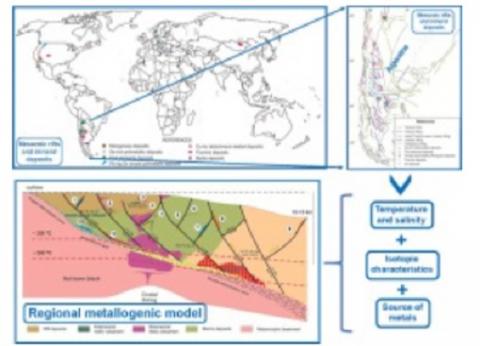Eduardo O. Zappettini, Nora Rubinstein, Sabrina Crosta, Susana J. Segal
2 017
Ore Geology Reviews
Mineral systems associated with extensional fault systems in continental environments and not related to magmatic activity involve various deposit models that can be grouped into a single system which would plausibly explain the source and chemical composition of fluids, the formation depth, the source of heat and the structural history within a common geologic setting.
Mineral deposits related to this tectonic setting are those described within the detachment-related model, including massive replacements, stockworks and veins of Cu and Fe oxides (with or without Au), polymetallic sulfide veins, barite and/or fluorite veins and stratabound and vein Mn deposits. This paper reviews the abovementioned deposits as well as others related to this tectonic setting, such as Se-rich polymetallic deposits, Almadén type Hg deposits, U-Ni-Co-As-Ag polymetallic deposits with subordinated Bi-Cu-Pb-Zn (five element deposits), simple polymetallic Pb-Ag-Zn deposits, and the members of the IOCG clan (including the Au-Ag detachment-related deposits) involved in the Cu-Fe (-Au) model deposits.
All these mineral deposits are the result of fluid motion unrelated to magmatism in areas of thermal anomalies. These fluids collect certain elements producing a district mineralogical specialization with inhomogeneities in the distribution of mineralization types along the region affected by rifting. Fluid homogenization temperatures and salinities range between 60° and 430 °C, and 0 and 27 equivalent wt% NaCl, respectively. The O, S and D isotope composition is consistent with basinal poral fluids derived from meteoric waters under different P-T conditions in an active faults environment. Pb isotopes suggest that Pb derives from a mixture of rocks with a long period of residence in the upper crust and rocks deformed along repeated orogenic cycles with a contribution of Pb from the lower crust and even the mantle. Fluid flow along fault planes leads to different types of hydrothermal alterations depending on P-T conditions, particularly propylitization and low temperature potassium metasomatism.
All such deposits can be found in two different geotectonic environments of metallogenic interest involving extensional faults associated with detachment zones in depth; i.e., 1) continental extension in a back-arc environment and 2) extension with rift development and generation of oceanic crust in a passive continental margin. Although the economic importance of this group of deposits is mainly related to industrial minerals, non-magmatic IOCG deposits could significantly augment the economic potential of this setting. The rift setting itself, without relation to detachments, is favorable for concentrating metals in stratabound deposits such as SEDEX ores. Additionally, the development of deposits directly related to magmatic activity contributes to the economic interest of this environment.
Mineral deposits related to this tectonic setting are those described within the detachment-related model, including massive replacements, stockworks and veins of Cu and Fe oxides (with or without Au), polymetallic sulfide veins, barite and/or fluorite veins and stratabound and vein Mn deposits. This paper reviews the abovementioned deposits as well as others related to this tectonic setting, such as Se-rich polymetallic deposits, Almadén type Hg deposits, U-Ni-Co-As-Ag polymetallic deposits with subordinated Bi-Cu-Pb-Zn (five element deposits), simple polymetallic Pb-Ag-Zn deposits, and the members of the IOCG clan (including the Au-Ag detachment-related deposits) involved in the Cu-Fe (-Au) model deposits.
All these mineral deposits are the result of fluid motion unrelated to magmatism in areas of thermal anomalies. These fluids collect certain elements producing a district mineralogical specialization with inhomogeneities in the distribution of mineralization types along the region affected by rifting. Fluid homogenization temperatures and salinities range between 60° and 430 °C, and 0 and 27 equivalent wt% NaCl, respectively. The O, S and D isotope composition is consistent with basinal poral fluids derived from meteoric waters under different P-T conditions in an active faults environment. Pb isotopes suggest that Pb derives from a mixture of rocks with a long period of residence in the upper crust and rocks deformed along repeated orogenic cycles with a contribution of Pb from the lower crust and even the mantle. Fluid flow along fault planes leads to different types of hydrothermal alterations depending on P-T conditions, particularly propylitization and low temperature potassium metasomatism.
All such deposits can be found in two different geotectonic environments of metallogenic interest involving extensional faults associated with detachment zones in depth; i.e., 1) continental extension in a back-arc environment and 2) extension with rift development and generation of oceanic crust in a passive continental margin. Although the economic importance of this group of deposits is mainly related to industrial minerals, non-magmatic IOCG deposits could significantly augment the economic potential of this setting. The rift setting itself, without relation to detachments, is favorable for concentrating metals in stratabound deposits such as SEDEX ores. Additionally, the development of deposits directly related to magmatic activity contributes to the economic interest of this environment.

